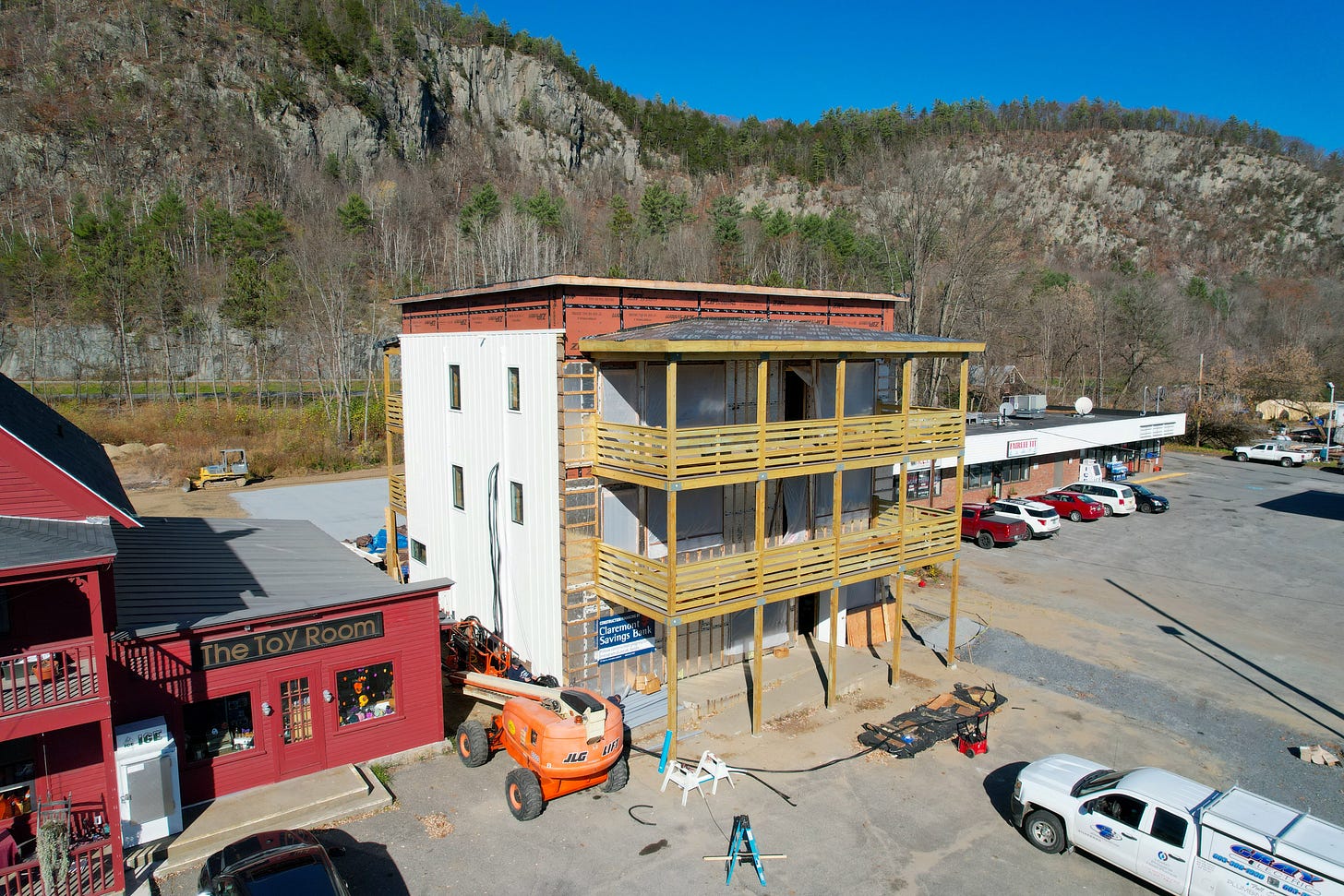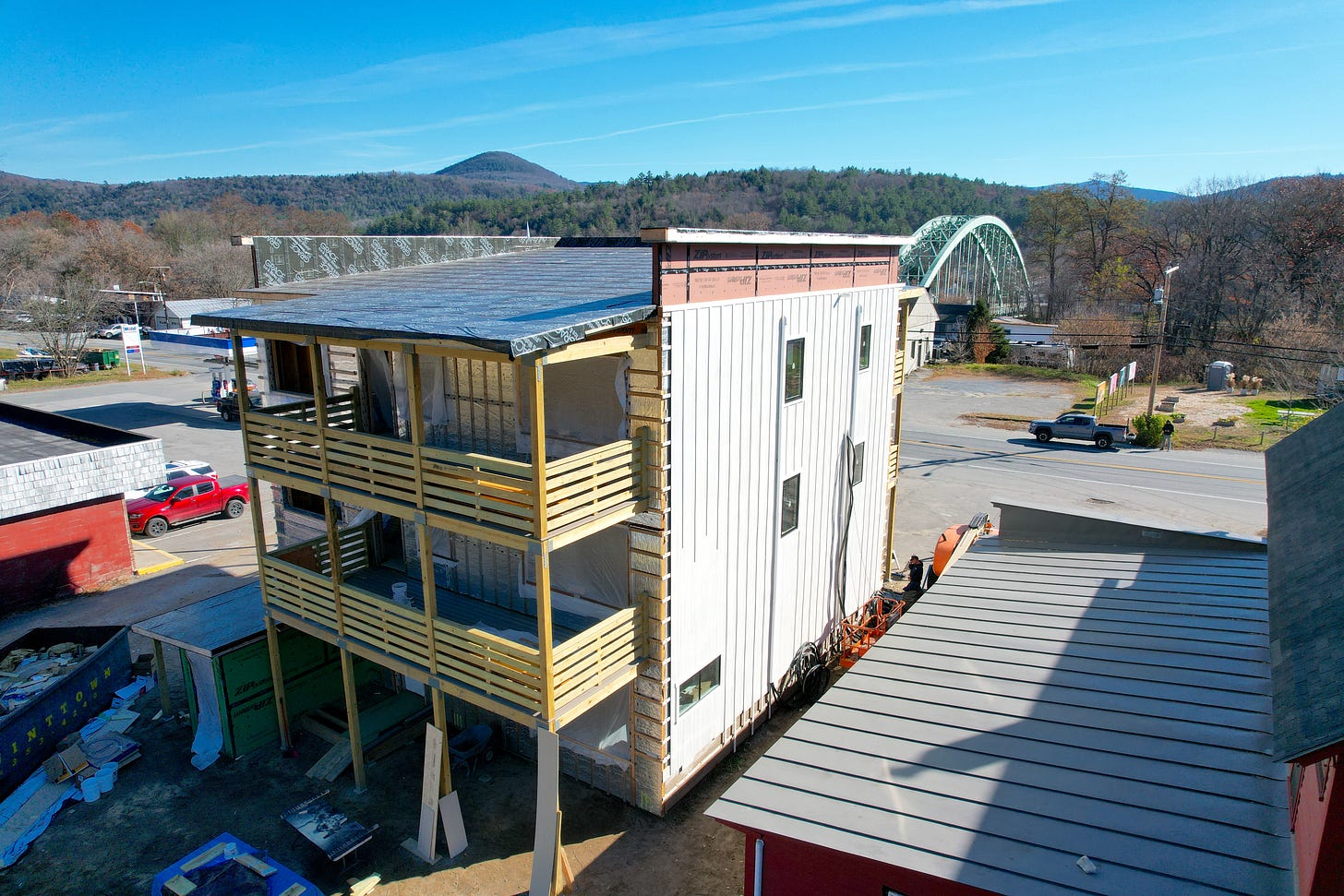Leveling The Playing Field (Pt 2)
The saga to develop a small-scale affordable housing project continues.
Hey. Welcome to the next edition of Small-Scale Sunday from Brick + Mortar where readers get insight into the acquisition, financing, design, construction, and operations of small-scale real estate development projects.
First, a few updates on 501 Main. Then, another rant on housing subsidies.
🎨 501 Main starts to come together
MEP is coming to a close. We’re on the home stretch for electrical and plumbing rough-ins. Woohoo!
Still waiting on most of the windows. They are now 3 weeks delayed after 17 weeks in production.
Thankfully, we received 5 of them and, after installing, we were able to start cladding one of the sides with LP Smartside board and batten.
Most of the site work out back is now done, too. And our massive septic system is in.
Nice to see the whole picture start to come together.
Onwards!
🎾 Playing the wrong game?
A few weeks ago, I wrote about the need to level the playing field for affordable housing subsidies.
ICYMI—small developers have fewer funding opportunities for affordable housing projects compared to the larger, more established shops.
And, as a result, this forces smaller developers to cater towards higher earners and market rate housing.
Most of our region’s village centers and downtowns are home to smaller-scale buildings. Traditional (larger) affordable housing projects don’t exactly fit the mold.
Yet, without a level playing field for housing subsidies, we jeopardize the further development of mixed-income neighborhoods in our smaller downtowns.
Ok. That’s the recap.
Since I wrote that post, two new details have come up.
So let’s keep the camera rolling.
First—
I applied to two affordable housing programs for my next project (a 6-unit adaptive reuse).
Last week, I heard back on my Upper Valley Loan Fund (UVLF) application.
Flat out rejected.
Simply due to the fact that the project doesn’t meet their 30-unit minimum.
I found this strange because I spoke with their VP of lending prior to applying. Not one mention of this during our conversation or subsequent emails.
Hours wasted on the application. But that’s fine. I’ll live.
What’s disheartening is that this could have been an innovative new local program to promote affordable housing in our region.
Instead, by mandating a 30-unit threshold, the program effectively eliminates projects in the majority of towns across the Upper Valley. That scale often doesn’t fit unless we’re isolating the apartments on the periphery of town.
If UVLF was a federal program, I’d understand.
But this fund is literally a consortium of local employers banding together to address housing affordability. Yet the scale of project they’re considering severely limits the location of acceptable projects.
Discouraging to say the least.
Second—
A local affordable housing developer pitched a 60-unit development last week in another town in our region.
The project will cater to people making 60% to 80% of the Area Median Income (AMI), or between $44,000 and $59,000 per year. Rents range from $1,200 to $1,400 for one-bedroom units.
This baffles me.
Here I am accepting VHIP funds — see last post — $50,000/unit in exchange for capping rents at HUD rates. $715 for studios, $750 for 1-bedrooms.
And yet larger developers are apparently handed less stringent rent restrictions based on a percentage of AMI instead of HUD rates.
All while getting access to bigger pots of housing subsidy.
It’s almost comical.
So not only do larger affordable housing projects qualify for the better funding opportunities, it turns out they’re also able to capture more rent per unit than us small fries.
It makes no sense.
The scales are so unbalanced it begs the question—why bother?
While I’m crawling around begging for scraps, these larger affordable housing developers are being treated to filet mignons and Dom Perignon.
The more I dig in, the more jaded I become.
Not only is the field not level, I’m not even allowed to play by the same rules.
The logical move would be to change games and focus on market rate housing—a game that’s more competitive, transparent, and accessible to the small developer.
My hope for finding a path to small-scale affordable housing is starting to fade, but I haven’t given up yet.
There are still a few programs I’m working on.
Let’s see how those play out (ha!).
Until next time.
— Jonah 🧱
P.S. Want to connect? Find me on LinkedIn and my projects on Instagram.






